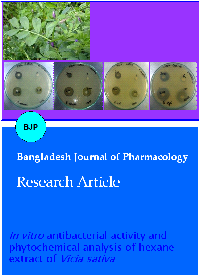In vitro antibacterial activity and phytochemical analysis of hexane extract of Vicia sativa
DOI:
https://doi.org/10.3329/bjp.v9i2.17859Keywords:
Antibacterial, HPLC, Phytochemical analysis, Vicia sativaAbstract
Vicia sativa is traditionally used medicinal plant in skin infections, asthma, bronchitis, urinary diseases and also used as antiseptic, anti-poison, aphrodisiac, anti rheumatic and antipyretic. In the present study n-hexane extract of V. sativa was evaluated for the antibacterial activity against pathogenic bacteria Staphylococcus aureus, Bacillus atrophaeus, Escherichia coli and S. epidermidis by disc diffusion method. Minimum inhibitory concentration of the n-hexane extract against all bacteria was determined by broth dilution method. Preliminary phytochemical analysis and HPLC analysis showed the presence of a number of bioactive constituents which exhibits antibacterial activity. So the current study showed that V. sativa possesses the significant antibacterial activity.
Downloads
2809
1655 Read
214
References
Agrawal PK. Carbon-13 NMR of flavonoids. Vol. 6, Elsevier, 1989, p 283.
Bashir AK, Abdalla AA, Wasfi IA, Hassan ES, Amiri MH, Crabb TA. Flavonoids of Limonium axillare. Pharmaceut Biol. 1994; 32: 366-72.
Boulos L. Flora of Egypt check list. Cairo, Egypt, Al Hadara Publishing, 1995, pp 204-06.
Chiang LC, Chiang W, Chiang MY, Ng LT, Lin CC. Antiviral activity of Plantago major extracts and related compounds in vitro. Antiviral Res. 2002; 55: 53-62.
Cushnie TP, Lamb AJ. Antimicrobial activities of flavonoids. Int J Antimicrob Agents. 2005; 26: 343.
Dwivedi S, Kaul S, Pandey D, Shrivastava S, Dwivedi SN. Status and conservation strategies of endangered and vulnerable medicinal plants. Planta Indica. 2008; 3: 13-15.
El-seedi AR, Ohara T, Sata N, Nishiyuma S. Antimicrobial terpenoids from Eupatorium glutinosum (Asteraceae). J Ethnopharmacol. 2002; 81: 293-96.
Erturis O, Demirbag Z. Scorzonare mollis Bieb (compositae) bitkisinin antimikrobiyal aktivitesi. Ekoloji cevre Dergisi. 2003; 12: 27-31.
Gebauer B, Schiltz E, Schimpl A, Rudiger H. Purification and characterization of a mitogenic lectin and a lectin-binding protein from Vicia sativa. Hoppe Seylers Z. Physiol Chem. 1979; 360: 1727-35.
Heatley NG. Method for the assay of penicillin. Biochem J. 1944; 38: 61-65.
Izzo AA. Drug interaction with St. Johns wort (Hypercum perforation): A review of the clinical evidence. Int J Clin Pharmacol Thera. 2004; 42: 139-48.
Khanna P, Sharma OP, Sehgal M. Antimicrobial principles from tissue culture of some plant species. Indian J Pharm Sci. 1980; 42: 113-17.
Levan M, Vanen Berghe DA, Mertes F. Medicinal plants and its importance in antimicrobial activity. J Planta Med. 1979; 36: 311-21.
Livermore D. Can better prescribing turn the tide of resistance? Rev Microbiol. 2004; 2: 73-78.
Meng J, Zhai RJ, Wyss AR. The late Paleocene Bayan Ulan fauna of inner Mongolia, China. Bull Carnegie Mus Nat Hist. 1998; 34: 148-85.
Mojab F, Kamalinejad M, Ghaderi N, Vahidipour HR. Phytochemical screening of some species of Iranian plants. Iranian J Pharmaceut Res. 2003; 4: 77-82.
Mothana R, Lindequist U, Gruenert R, Bednarski P. Studies of the in vitro anticancer, antimicrobial and anti-oxidant potentials of selected Yemeni medicinal plants from the island Soqotra. BMC Complement Altern Med. 2009; 9: 1-11.
Nierle W, Baya AW. Study and composition of some legumes. ZLUF. 1977; 164: 23-27.
Nowak R, Kawka S. Phenolic acids in leaves of Secamone afzeli (Rhoem.) Schult. (Asclepiadaceae). Acta Soc Bot Pol. 1998; 67: 243.
Palacios P, Gutkind G, Rondina RV, de Torres R, Coussio JD. Genus Baccharis. II. Antimicrobial activity of B. crispa and B. notosergila. Planta Medica. 1983; 49: 128.
Rauha JP, Remes S, Heinonen M, Hopia A, Kahkonen M, Kujala T, Pihlaja K, Vuorela H, Vuorela P. Antimicrobial effects of Finnish plant extracts containing flavonoids and other phenolic compounds. Int J Food Microbiol. 2000; 56: 3-12.
Rojas, Bustamante B, Bauer J, Fernandez I, Alban J, Lock O. Antimicrobial activity of selected Peruvian medicinal plants. J Ethnopharmacol. 2003; 88: 199-204.
Roy DN, Sabri MI, Kayton RJ, Spencer PS. Nat Toxins. 1996; 4: 247-53.
Seabra M, Carvalho S, Freire J, Ferreira R, Mourato M, Cunha L, Cabral F, Teixeira A, Aumaitre A. Lupinus luteus, Vicia sativa and Lathyrus cicera as protein sources for piglets: Ileal and total tract apparent digestibility of amino acids and antigenic effects. Anim Feed Sci Technol. 2001; 89: 1-16.
Sharma PP, Roy RK, Anurag GD. Pentacyclic triterpinoids from Betula utilis and Hyptis suaveolens. Int J Pharm Tech Res. 2010; 2: 1558-32.
Shinwari MI, Khan MA. Folk use of medicinal herbs of Margalla Hills National Park, Islamabad. J Ethnopharmacol. 2000; 69: 45-56.
Sofowora A. Medicinal plants and traditional medicine in Africa. New York, John Wiley and Sons Ltd, 1993.
Sudharameshwari K, Radhika J. Antibacterial screening of Aegle marmelos, Lawsonia inermis and Albizzia libbeck. Afr J Trad Complem Altern Med. 2007; 4: 199-204.
Sultana B, Anwar F, Rafique M, Chatha SAS. Anti-oxidant potential of extracts from different agro wastes: Stabilization of corn oil. Grasas y aceites. 2008; 59: 205-17.
Tschiersch B, Hanelt P. Flora. California USA, Blackwell, 1966, 157: 389-92.

Published
How to Cite
Issue
Section
License
Authors who publish with this journal agree to the following terms:
- Authors retain copyright and grant the journal right of first publication with the work simultaneously licensed under a Creative Commons Attribution License that allows others to share the work with an acknowledgement of the work's authorship and initial publication in this journal.
- Authors are able to enter into separate, additional contractual arrangements for the non-exclusive distribution of the journal's published version of the work (e.g., post it to an institutional repository or publish it in a book), with an acknowledgement of its initial publication in this journal.
- Authors are permitted and encouraged to post their work online (e.g., in institutional repositories or on their website) prior to and during the submission process, as it can lead to productive exchanges, as well as earlier and greater citation of published work (See The Effect of Open Access).
